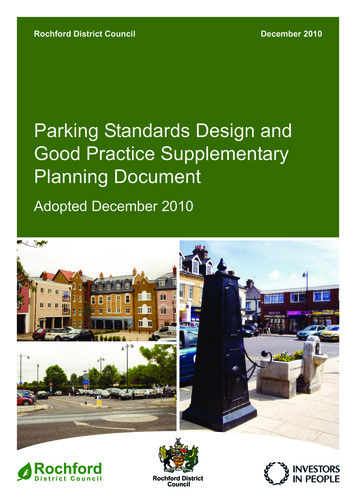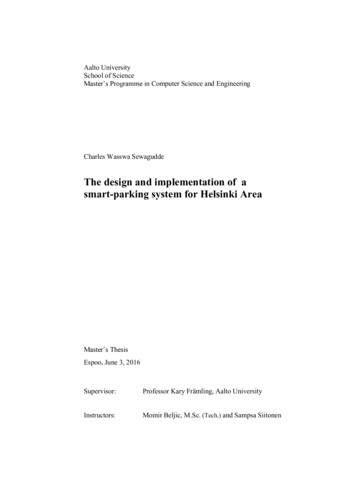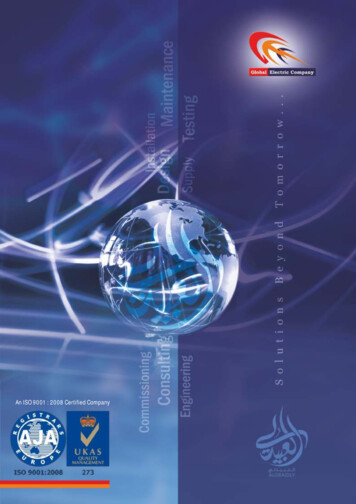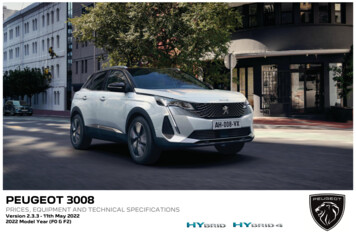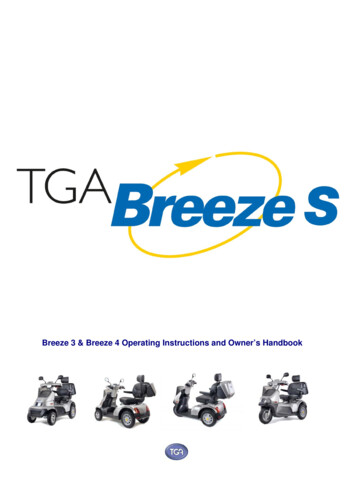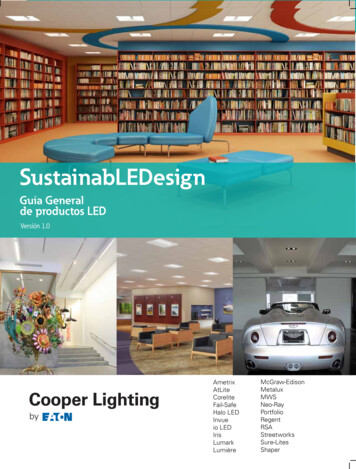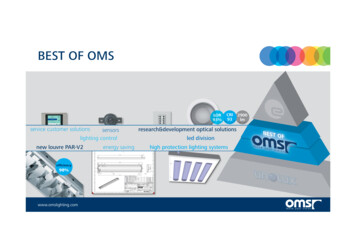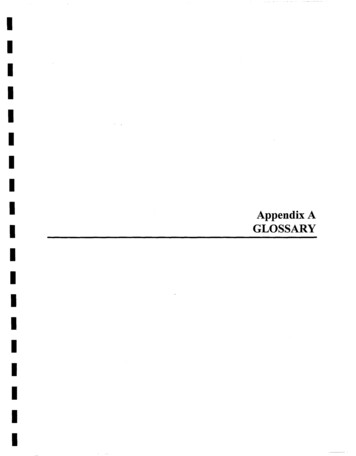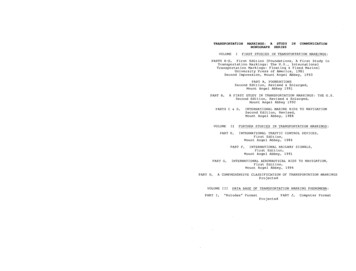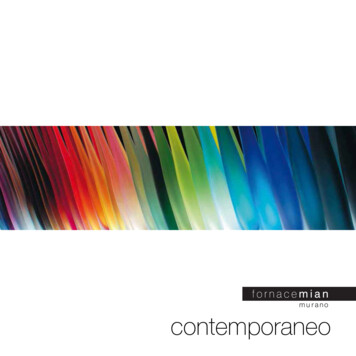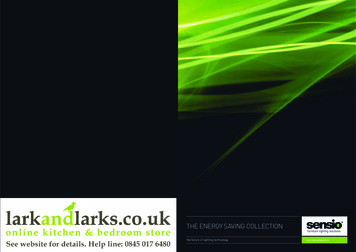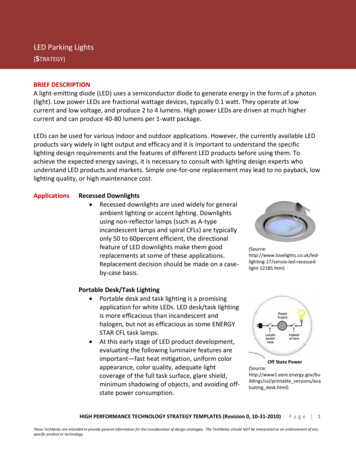
Transcription
LED Parking Lights[STRATEGY]BRIEF DESCRIPTIONA light-emitting diode (LED) uses a semiconductor diode to generate energy in the form of a photon(light). Low power LEDs are fractional wattage devices, typically 0.1 watt. They operate at lowcurrent and low voltage, and produce 2 to 4 lumens. High power LEDs are driven at much highercurrent and can produce 40-80 lumens per 1-watt package.LEDs can be used for various indoor and outdoor applications. However, the currently available LEDproducts vary widely in light output and efficacy and it is important to understand the specificlighting design requirements and the features of different LED products before using them. Toachieve the expected energy savings, it is necessary to consult with lighting design experts whounderstand LED products and markets. Simple one-for-one replacement may lead to no payback, lowlighting quality, or high maintenance cost.ApplicationsRecessed Downlights Recessed downlights are used widely for generalambient lighting or accent lighting. Downlightsusing non-reflector lamps (such as A-typeincandescent lamps and spiral CFLs) are typicallyonly 50 to 60percent efficient, the directionalfeature of LED downlights make them goodreplacements at some of these applications.Replacement decision should be made on a caseby-case basis.Portable Desk/Task Lighting Portable desk and task lighting is a promisingapplication for white LEDs. LED desk/task lightingis more efficacious than incandescent andhalogen, but not as efficacious as some ENERGYSTAR CFL task lamps. At this early stage of LED product development,evaluating the following luminaire features areimportant—fast heat mitigation, uniform colorappearance, color quality, adequate lightcoverage of the full task surface, glare shield,minimum shadowing of objects, and avoiding offstate power f State /ssl/printable versions/evaluating desk.html)HIGH PERFORMANCE TECHNOLOGY STRATEGY TEMPLATES (Revision 0, 10-31-2010)Page 1These TechNotes are intended to provide general information for the consideration of design strategies. The TechNotes should NOT be interpreted as an endorsement of anyspecific product or technology.
LED Parking Lights[STRATEGY]Undercabinet Lighting Taking advantage of LED’s directionality and small size, undercabinet LEDlighting is potentially a good application. The directionality of LEDs allows alarger proportion of the available light to be directed where it is needed,instead of lost within the fixture. LED undercabinet fixtures are more expensive than most other fixtures. Thefollowing product features need to be considered—heat mitigation, beampatterns, color quality, minimum shadowing.Exit Signs Exit signs operate 24 hours and can consume a large amount of energy.Compared to older exit sings using incandescent or fluorescent lights, LED exitsigns use ultra-low energy and are cost-effective. Longer lamp life also reduce the maintenance costs.(Source: http://www.energystar.gov/ia/business/small business/led exitsigns techsheet.pdf)Outdoor Area lighting Compared to metal halide andhigh-pressure sodium sources,which are the currently dominantoutdoor lights, well-designed LEDoutdoor luminaires can providerequired lighting levels using lessenergy and improve lightinguniformity. LED luminaires alsoLED parking lot lights (left) compared to HPShave 1.5 to 3 times longer life with lights (right) show different color appearanceand more uniformed light distribution.better lumen maintenance.(Source: s/pdfs/ssl/outdoor area lighting.pdf)Design Notes Well-designed Luminaire LED product quality varies significantly among manufactures. It is importantHIGH PERFORMANCE TECHNOLOGY STRATEGY TEMPLATES (Revision 0, 10-31-2010)Page 2These TechNotes are intended to provide general information for the consideration of design strategies. The TechNotes should NOT be interpreted as an endorsement of anyspecific product or technology.
LED Parking Lights[STRATEGY] to collect sufficient information of the product’s long-term performance databesides energy savings. Information sources include CALiPER test results andGATEWAY demonstration program reports (available atwww.netl.doe.gov/ssl)Given the current challenge in specifying quality LED indoor lighting products,this TechNote highlights a proven successful application of LED lighting –parking lots.Outdoor Maintenance Optical chamber should remain clean to reduce maintenance. It is important to check the Ingress Protection (IP) rating for the condition inwhich the luminaire will be used and choose an appropriate rating for theintended application. A disconnect point between the light engine and the drivers will allow forfield maintenance.RelatedTechnologiesLight Pollution ReductionReferences/Useful Resources:[1] LED Application Series: Outdoor Area blications/pdfs/ssl/outdoor area lighting.pdf[2] Solid-State Lighting: LED Applications. http://www1.eere.energy.gov/buildings/ssl/app series.htmlHIGH PERFORMANCE TECHNOLOGY STRATEGY TEMPLATES (Revision 0, 10-31-2010)Page 3These TechNotes are intended to provide general information for the consideration of design strategies. The TechNotes should NOT be interpreted as an endorsement of anyspecific product or technology.
LED Parking Lights[ENERGY AND ENVIRONMENT]Energy SavingsLighting Energy When lighting is properly designed and LED products are carefullyselected, LED lighting can significantly reduce indoor and outdoor energyconsumptions. However, the savings cannot be generalized due to thevariety of compared light sources and applications.Cooling Energy Reduced lighting load yields to lower cooling energy use. The savingsderive from the reduced need to remove heat from electric lighting andthe reduced cooling necessary to condition ventilation air.GuidingPrinciples1Optimize Energy Performance (Energy Efficiency) Reduce the energy use by 30 percent compared to the baseline buildingperformance rating per ASHRAE Standard 90.1-2007.AssociatedLEED Credits(NC 2009)2EAc1: Optimize Energy Performance (1-19 points) Demonstrate a percentage improvement in energy performancecompared to a baseline performance per ASHRAE/IESNA Standard 90.12007.1Guiding Principles for Federal Leadership in High Performance and Sustainable Buildingswww.wbdg.org/pdfs/hpsb guidance.pdf2USGBC LEED Reference Guide for Green Building Design and Construction, 2009 EditionHIGH PERFORMANCE TECHNOLOGY STRATEGY TEMPLATES (Revision 0, 10-31-2010)Page 4These TechNotes are intended to provide general information for the consideration of design strategies. The TechNotes should NOT be interpreted as an endorsement of anyspecific product or technology.
LED Parking Lights[PRODUCT AND ECONOMICS]NOTE: The product information is specifically for LED outdoor lighting.ProductImages(Source: s/pdfs/ssl/outdoor area ere.energy.gov/buildings/ssl/outdoor checklist.html )ComponentsHousing, Light subassembly, Electrical systems subassemblyCost Range 700 – 1500 per fixture (Mounting pole is not included.)VendorsGE LED outdoor 01/r2/productcentral/htmls/2 4.htmlGardco Lighting and Emco Lightinghttp://www.sitelighting.com/LuminosityLED reet-lighting.htmlWarrantyInfo3 – 5 yearsCodeRestrictions NoneHIGH PERFORMANCE TECHNOLOGY STRATEGY TEMPLATES (Revision 0, 10-31-2010)Page 5These TechNotes are intended to provide general information for the consideration of design strategies. The TechNotes should NOT be interpreted as an endorsement of anyspecific product or technology.
LED Parking Lights[SPECIFICATIONS]SECTION 26 50 00 (SECTION 16500) – LIGHTING3A.General Description: The complete shall be capable of starting and operating the light enginewithin the limits specified by the LED manufacturer. The luminaire shall contain completelyprewired integral drivers and an optical assembly that shall provide a distribution type,specified according to photometric selection table. Labeling shall be in accordance with ANSIstandards. All units shall be UL/cUL Certified.B.Product1. Photometric Performance of installed units:Examine luminaire photometric files in standard IES file format from qualifiedindependent or qualified manufacturer-based laboratories. The photometric test reportsshould be based on the IESNA LM-79-08 test procedure. The photometry should be basedon an actual working product, not a prototype or computer model.Lumen output and efficacy (lm/W) should not be used to generalize the performance ofall luminaires. Downward fixture efficiency should be considered to analyze illuminancelevels provided to the target areas, both horizontal and vertical, using lighting designsoftware and actual site measurements.2. Durability: Look for an Ingress Protection (IP) rating appropriate to the intendedapplication condition.3. Color: Check correlated color temperature (CCT) for the intended application. Colorrendering index (CRI) of 50 or higher are adequate for most street and area lightingapplications.4. Operating temperature: Check operating temperature information of the product andhow it affects the luminaire efficacy and lumen depreciation.5. Glare Control: Assess glare at intended mounting height and under typical nighttimeviewing conditions.6. Product Warranty: The manufacture should replace the product if it fails before 5 years.3LED Application Series: Outdoor Area blications/pdfs/ssl/outdoor area lighting.pdfHIGH PERFORMANCE TECHNOLOGY STRATEGY TEMPLATES (Revision 0, 10-31-2010)Page 6These TechNotes are intended to provide general information for the consideration of design strategies. The TechNotes should NOT be interpreted as an endorsement of anyspecific product or technology.
A light-emitting diode (LED) uses a semiconductor diode to generate energy in the form of a photon (light). Low power LEDs are fractional wattage devices, typically 0.1 watt. They operate at low current and low voltage, and produce 2 to 4 lumens. High power LEDs are driven at much higher current and can produce 40-80 lumens per 1-watt package.
